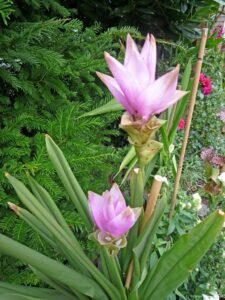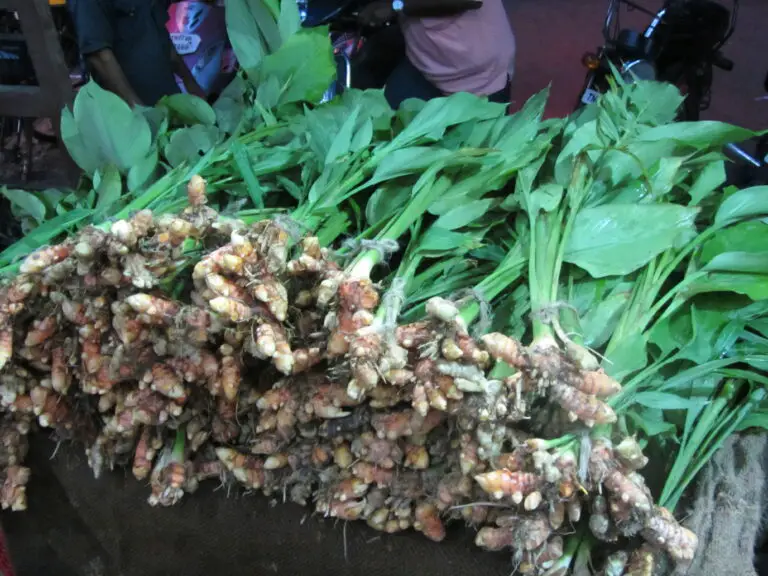Turmeric, known as “Indian saffron” is famous for its vibrant golden color and its culinary applications. Yet, it offers much more than a delightful taste. Recently, turmeric in the garden has gained attention for its remarkable potential in both agriculture and horticulture. This versatile Curcuma longa plant holds not only health benefits but also exciting uses in gardening and farming.
In this comprehensive guide, we will delve into the world of turmeric, exploring its diverse applications, from enhancing agricultural yields to creating stunning horticultural displays. We’ll cover everything from growing turmeric to using it as a natural pesticide in your garden. So, let’s embark on a journey to discover the magic of turmeric in the garden.
Agricultural Uses of Turmeric

Turmeric has a rich history in agriculture, dating back centuries in Southeast Asia. The primary agricultural use of turmeric is as a crop booster and soil enhancer. Its rhizomes, or underground stems, exude compounds that promote soil health. Curcumin, a compound found in turmeric, can significantly improve drainage and overall soil structure, which is essential for healthy plant growth. Moreover, planting turmeric alongside other crops can yield impressive results, thanks to its natural healing properties.
Turmeric in the Garden: A Natural Repellent
Garden pests often wreak havoc on our beloved plants. From common pests to harmful insects, our gardens are not safe from their attacks. However, turmeric can be your natural repellent against these intruders. Using fresh turmeric leaves or creating a thick paste from turmeric powder and applying it to plant wounds can help deter pests. For those pesky bug bites, turmeric’s anti-inflammatory properties come to the rescue, promoting the healing of damaged plants.
Curcuma Longa for Crop Protection
Aside from repelling pests, turmeric’s use extends to protecting crops from fungal infections. Many gardeners turn to synthetic antifungal treatments, but turmeric offers an organic and sustainable alternative. Its properties, when harnessed properly, can fend off fungal diseases like powdery mildew and leaf spot, keeping your plants healthy and thriving.
Horticultural Uses of Turmeric

Horticultural Uses of Turmeric
In addition to its role in agriculture, turmeric is making a name for itself in the world of horticulture. Its bright yellow hue and lush foliage make it a stunning addition to any garden. Here are some ways in which turmeric can elevate your horticultural endeavors:
Turmeric: Aesthetic Brilliance
Gardeners have embraced turmeric for its aesthetic brilliance. This vibrant plant adds a pop of color to any garden with its lush, green leaves and vibrant flowers. Whether you’re creating a tropical paradise or a Zen-inspired space, turmeric’s presence can’t be ignored.
Natural Pest Control in Ornamental Plants
Ornamental plants often fall prey to garden pests, which can mar the beauty of your landscape. Turmeric, however, can be a savior. Its natural pesticide properties can protect your garden plants from various common pests, ensuring they remain healthy and vibrant.
Turmeric as a Natural Fertilizer
Turmeric leaves, once decomposed, enrich the soil with organic matter. This makes them an excellent natural fertilizer, enhancing the growth of your ornamental plants. It’s a sustainable way to nourish your garden while reducing waste.
Growing Turmeric

Growing Turmeric at Home
Now that we’ve explored the agricultural and horticultural uses of turmeric, let’s get practical and learn how to grow this magical plant at home. It’s not as daunting as it may seem. Here’s a step-by-step guide to get you started:
1. Select the Right Turmeric Rhizomes
Choose fresh turmeric rhizomes from a reliable source, which you can find at your local grocery store or specialized garden centers. Look for firm, plump rhizomes.
2. Prepare the Soil
Turmeric thrives in well-draining, fertile soil. Before planting, ensure the soil is rich in organic matter, and improve drainage to prevent rhizome rot.
3. Planting Turmeric
Plant turmeric in early spring, as it prefers warmer temperatures. Use a garden fork to dig holes about 3-4 inches deep and place the rhizomes about 6-8 inches apart. Cover them with soil and water well.
4. Sunlight and Water
Turmeric plants require full sun, so choose a sunny spot in your garden. Water consistently to keep the soil evenly moist, but avoid waterlogging.
5. Caring for Turmeric
During the growing season, be vigilant for signs of fungal infection and plant diseases. If needed, apply a natural pesticide like neem oil.
6. Harvesting
Turmeric is ready for harvest when the leaves turn yellow, typically after 8-10 months. Carefully dig up the rhizomes, clean them, and use fresh turmeric root or dry them for turmeric powder.
Final Thoughts
Turmeric, once known solely for its culinary uses, has now found a valuable place in the garden. Its agricultural uses range from enhancing soil quality to repelling pests, while in horticulture, it adds a burst of color and serves as a natural protector for your ornamental plants. The process of growing turmeric at home is both rewarding and sustainable, allowing you to enjoy fresh turmeric root while improving your garden’s health.
By harnessing the potential of turmeric in gardening, horticulturists and farmers have the opportunity to create a naturally nurturing and secure setting for their plants. Bid farewell to detrimental synthetic remedies and welcome the organic pest-repelling attributes of turmeric.
Its beneficial influence ranges from aiding plant recovery to enhancing the vitality of the soil. Therefore, go ahead and introduce turmeric into your garden, allowing its dynamic presence to metamorphose your garden into a genuine Eden. Your plants will express their gratitude for this choice!

